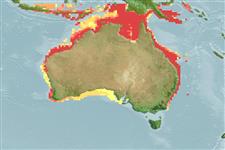>
Scombriformes (Mackerels) >
Scombridae (Mackerels, tunas, bonitos) > Scombrinae
Etymology: Scomberomorus: Latin, scomber = mackerel + Greek, moros = silly, stupid (Ref. 45335).
Environment: milieu / climate zone / depth range / distribution range
Ecologia
marinhas; oceanódromo (Ref. 51243); intervalo de profundidade ? - 100 m (Ref. 6390). Tropical; 6°S - 38°S, 110°E - 157°E (Ref. 168)
Western Pacific: restricted to the northern coast of Australia, from the Abrolhos Islands region of Western Australia to Coffs Harbor and Kempsey in central New South Wales; also occurring in southern Papua New Guinea from Kerema to Port Moresby.
Length at first maturity / Tamanho / Peso / Idade
Maturity: Lm ?, range 61 - ? cm
Max length : 104 cm FL macho/indeterminado; (Ref. 6390); peso máx. Publicado: 10.2 kg (Ref. 3132)
Espinhos dorsais (total): 20 - 22; Raios dorsais moles (total): 17-20; Espinhos anais 0; Raios anais moles: 17 - 19; Vértebras: 50 - 52. Interpelvic process small and bifid. Lateral line gradually curving down toward caudal peduncle. Intestine with 2 folds and 3 limbs. Swim bladder absent. Body covered with small scales. Sides with several poorly defined rows of round spots, larger than pupil but smaller than eye diameter. The inner surface of the pectoral fin is dark blue, the cheeks and belly silvery white, the anal fin and anal finlets light silvery gray, and the dorsal fin black, bright steely blue when fresh.
Found more commonly in offshore, open waters away from reefs and shoals (Ref. 30199). Form large schools which move close inshore along the coast of Queensland, commonly taken between December and April or May. Feed largely on fishes, particularly anchovies and sardines with smaller quantities of shrimps and squids. Common fork length ranges between 50 to 80 cm (Ref. 168). Sometimes confused with S. niphonius.
Life cycle and mating behavior
Maturidade | Reprodução | Desova | Ovos | Fecundidade | Larvas
Collette, B.B. and C.E. Nauen, 1983. FAO Species Catalogue. Vol. 2. Scombrids of the world. An annotated and illustrated catalogue of tunas, mackerels, bonitos and related species known to date. Rome: FAO. FAO Fish. Synop. 125(2):137 p. (Ref. 168)
Categoria na Lista Vermelha da IUCN (Ref. 130435)
Ameaça para o homem
Reports of ciguatera poisoning (Ref. 6390)
Utilização humana
Pescarias: espécies comerciais; peixe desportivo: sim
Mais informação
ReferênciasAquaculturaPerfil para aquaculturaEstirpesGenéticaElectrophoresesHereditariedadeDoençasProcessamentoNutrientsMass conversion
Ferramentas
Relatórios especiais
Descarregue XML
Fontes da internet
Estimates based on models
Preferred temperature (Ref.
123201): 22.5 - 28.6, mean 27.5 °C (based on 574 cells).
Phylogenetic diversity index (Ref.
82804): PD
50 = 0.5000 [Uniqueness, from 0.5 = low to 2.0 = high].
Bayesian length-weight: a=0.00832 (0.00383 - 0.01808), b=3.03 (2.86 - 3.20), in cm total length, based on LWR estimates for this Genus-body shape (Ref.
93245).
Nível Trófico (Ref.
69278): 4.3 ±0.76 se; based on food items.
Resiliência (Ref.
120179): Médio, tempo mínimo de duplicação da população 1,4 - 4,4 anos (K=0.23-0.46; tm=1-2; tmax=7).
Fishing Vulnerability (Ref.
59153): Moderate vulnerability (36 of 100).
